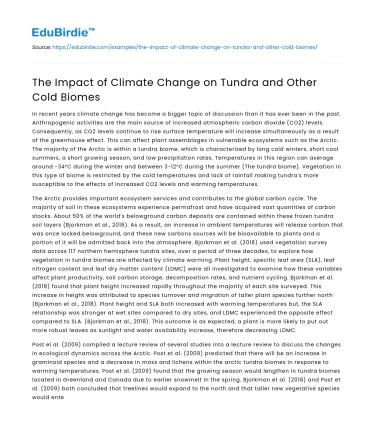In recent years climate change has become a bigger topic of discussion than it has ever been in the past. Anthropogenic activities are the main source of increased atmospheric carbon dioxide (CO2) levels. Consequently, as CO2 levels continue to rise surface temperature will increase simultaneously as a result of the greenhouse effect. This can affect plant assemblages in vulnerable ecosystems such as the Arctic. The majority of the Arctic is within a tundra biome, which is characterized by long cold winters, short cool summers, a short growing season, and low precipitation rates. Temperatures in this region can average around -34°C during the winter and between 3-12°C during the summer (The tundra biome). Vegetation in this type of biome is restricted by the cold temperatures and lack of rainfall making tundra’s more susceptible to the effects of increased CO2 levels and warming temperatures.
The Arctic provides important ecosystem services and contributes to the global carbon cycle. The majority of soil in these ecosystems experience permafrost and have acquired vast quantities of carbon stocks. About 50% of the world’s belowground carbon deposits are contained within these frozen tundra soil layers (Bjorkman et al., 2018). As a result, an increase in ambient temperatures will release carbon that was once locked belowground, and these new carbons sources will be bioavailable to plants and a portion of it will be admitted back into the atmosphere. Bjorkman et al. (2018) used vegetation survey data across 117 northern hemisphere tundra sites, over a period of three decades, to explore how vegetation in tundra biomes are affected by climate warming. Plant height, specific leaf area (SLA), leaf nitrogen content and leaf dry matter content (LDMC) were all investigated to examine how these variables affect plant productivity, soil carbon storage, decomposition rates, and nutrient cycling. Bjorkman et al. (2018) found that plant height increased rapidly throughout the majority of each site surveyed. This increase in height was attributed to species turnover and migration of taller plant species further north (Bjorkman et al., 2018). Plant height and SLA both increased with warming temperatures but, the SLA relationship was stronger at wet sites compared to dry sites, and LDMC experienced the opposite effect compared to SLA. (Bjorkman et al., 2018). This outcome is as expected, a plant is more likely to put out more robust leaves as sunlight and water availability increase, therefore decreasing LDMC.
Save your time!
We can take care of your essay
- Proper editing and formatting
- Free revision, title page, and bibliography
- Flexible prices and money-back guarantee
Post el al. (2009) compiled a lecture review of several studies into a lecture review to discuss the changes in ecological dynamics across the Arctic. Post et al. (2009) predicted that there will be an increase in graminoid species and a decrease in moss and lichens within the arctic tundra biomes in response to warming temperatures. Post et al. (2009) found that the growing season would lengthen in tundra biomes located in Greenland and Canada due to earlier snowmelt in the spring. Bjorkman et al. (2018) and Post et al. (2009) both concluded that treelines would expand to the north and that taller new vegetative species would enter the tundra ecosystems. This ecological shift would only aid in the abundance of more complex plant species by promoting microbial productivity, nutrient availability, and increasing soil temperatures within tundra soils.
The bioavailability of carbon, warming temperatures, and increased water ability due to snowmelt will cause ecological shifts in arctic habitats. Polar artic deserts will shift into tundra biomes and tundra biomes will shift into boreal forests (Artic Climate Change). These shifts can have detrimental impacts on not only the vegetation but also the fauna that reside in these areas. Animals that were highly adapted to the extremely cold environments will become extinct as they’re outcompeted by invading species as a result of shifting habitats.
Did you like this example?
Make sure you submit a unique essay
Our writers will provide you with an essay sample written from scratch: any topic, any deadline, any instructions.
Cite this paper
-
APA
-
MLA
-
Harvard
-
Vancouver
The Impact of Climate Change on Tundra and Other Cold Biomes.
(2022, September 15). Edubirdie. Retrieved December 22, 2024, from https://edubirdie.com/examples/the-impact-of-climate-change-on-tundra-and-other-cold-biomes/
“The Impact of Climate Change on Tundra and Other Cold Biomes.” Edubirdie, 15 Sept. 2022, edubirdie.com/examples/the-impact-of-climate-change-on-tundra-and-other-cold-biomes/
The Impact of Climate Change on Tundra and Other Cold Biomes. [online].
Available at: <https://edubirdie.com/examples/the-impact-of-climate-change-on-tundra-and-other-cold-biomes/> [Accessed 22 Dec. 2024].
The Impact of Climate Change on Tundra and Other Cold Biomes [Internet]. Edubirdie.
2022 Sept 15 [cited 2024 Dec 22].
Available from: https://edubirdie.com/examples/the-impact-of-climate-change-on-tundra-and-other-cold-biomes/
copy






 Stuck on your essay?
Stuck on your essay?

